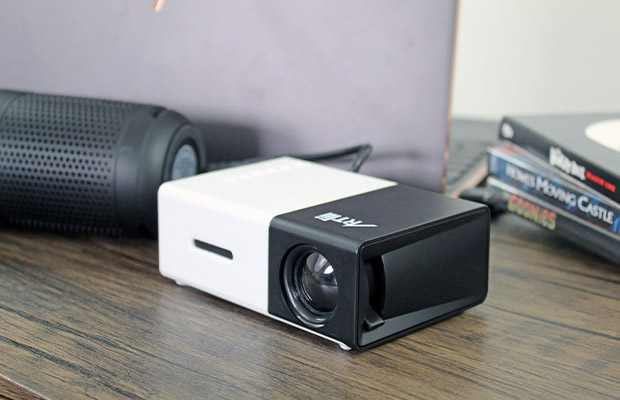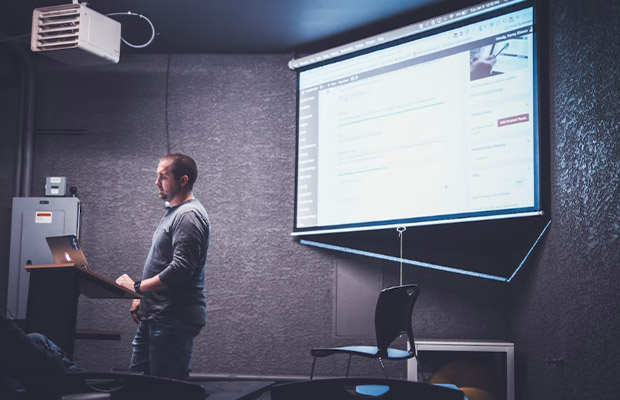There are many advantages to using a projector in a classroom, and since there are so many models available, you can still get a high-quality device while staying within your budget.
The best projector for school should be large enough for the children in the back to see it, bright enough to block out window light, and reasonably priced so that school districts can purchase a number of them.
Read on to find out more about the top ten projectors for schools and the features you should look for when shopping.
Table of Contents
Best Projector List For School
- 1. Optoma EH412ST Projector
- 2. CiBest Video Projector
- 3. YABER Y30 Projector
- 4. BIGASUO Pro302 Projector
- 5. DBPOWER Bluetooth Projector
- 6. TOPVISION T6 Projector
- 7. PVO YG300Pro Projector
- 8. HOMPOW 5500L Movie Projector
- 9. AZEUS Ture 6000
- 10. Epson EpiqVision Ultra LS300
Also Read: Best iPhone Projector
Best Projector For School Review
1. Optoma EH412ST Projector
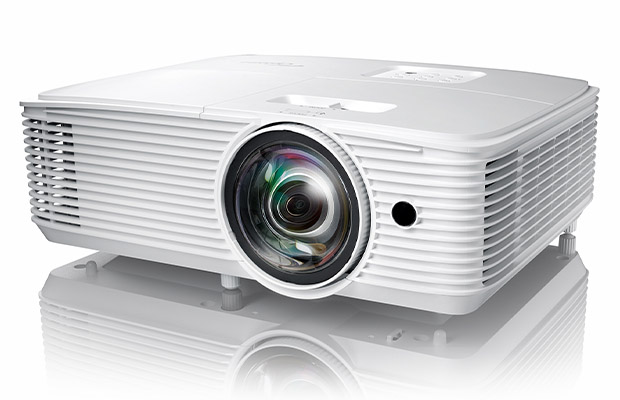
Why We Like It: This projector is best for professors and higher-level teachers. It has a slim design and a small projection ratio. The dazzling projections made possible by the bright lamp on board will be greatly appreciated.
Pros
- Extreme longevity for lamp
- Features a 10-watt speaker
- Provides high lumens
Cons
- Corporate appearance
The bright projections, which have a 4,000-lumen lamp that can last for 15,000 hours, will be very useful to teachers. It can provide life for more than 15,000 hours. Additionally, it is very portable. On the other hand, due to its corporate appearance, it is probably inappropriate for early childhood educators. Children typically require more stimulating visual environments for their developing brains.
Volume is transmitted throughout a lecture hall by the built-in sound system. Numerous interfaces, such as USB, HDMI, and VGA, are compatible with this model. Even in small spaces, you can use it thanks to the short-throw lens. A serge color profile improves the vivid color accuracy that a 50,000:1 contrast ratio offers. To fully appreciate the depth of the vivid imagery, pair it with a PC or Mac that can reproduce colors accurately. Check out our informational article on how to correct color on a projector for assistance with any color-related problems.
2. Cibest Video Projector
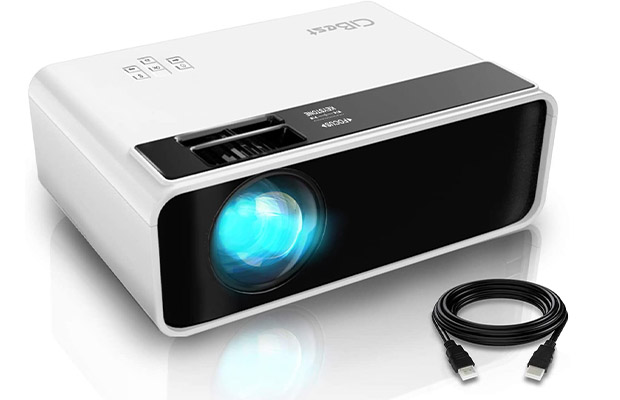
Why We Like It: This is the best model if you regularly host classes outside. Having a 7,500-lumen output, it is intended to be visible even on sunny days. You’ll appreciate a variety of features that make it a potent addition to your educational toolkit.
Pros
- Extreme maneuverability
- Multiple connection interfaces
- Can be used inside or outside
Cons
- Lower definition than other models
When you select this option, you won’t require any complicated dongles. This projector is compatible with a variety of hardware interfaces. Using either a high-definition multimedia interface connection or a universal serial bus will not affect you in any way. The potent lamp is also 7,000 lumens. The model’s inability to deliver high-definition images is a drawback compared to the competition.
Although it costs less than other models on our list, it is still of excellent quality. This model is adaptable for use in classrooms and can be used for everything from presentations to instructional videos. The 2000:1 contrast ratio makes for a much brighter image. Any ambient light can be dispersed with diffuse reflection technology. It has built-in speakers for better sound without additional setup. Simply connect your own set of speakers using the 3.5mm audio output if the speakers don’t deliver the sound quality you’re after.
3. Yaber Y30 Projector
Why We Like It: This projector offers a far superior high-definition viewing experience. The best method for bringing any educational film to life is this one. Given that it supports high-definition video, the projections are simply amazing.
Pros
- Extremely high definition
- Syncs with smartphones
- High lumens option
Cons
- Projects poorly in big, dark rooms
There is a lot to be said about this projector’s picture quality. Any educational program or movie will be available for you to view in real-time. It was designed with the intention of being used in homes for family movie nights. As a result, it actually projects the best images. Though concentrated, this power. In a dimly lit room, you might have trouble projecting over a distance.
Without adjusting the projection distance, full placement control is possible when an X/Y zoom function is used. Additionally, you’ll be able to connect via HDMI, USB, AV, and VGA. It can work with enormous projector screens, which is the final benefit. For a lecture hall where screens must be both long and wide to give all students a full view, this is excellent news.
4. Bigasuo Pro302 Projector
Why We Like It: Anywhere and with any connection method, you can use this projector. While it accepts wired connections, it also supports wireless ones. It plays discs, which is its biggest perk for educators.
Pros
- Accepts wireless connections
- The built-in system plays discs
- Multiple ways to mount
Cons
- Somewhat technical set-up
To connect with a particular interface, do you need to? It almost certainly works with this projector. It will even establish a wireless connection with your gadget. In addition, there are advantages like improved color details and brightness. It does, however, have a more technical setup than the alternatives, so take that into consideration. Due to the advanced technology it includes, this trade-off is expected. Even so, the majority of schools provide tech support to get you through the most difficult times.
A native 720P resolution and an 8000:1 contrast ratio contribute to the increased brightness. Particularly when you consider the overall picture quality, picture reproduction tends to be much richer than in lower-quality models. This projector model prefers flash drives, which are widely available in schools. Between your computer and projector, you’ll be able to seamlessly transfer presentations or other video data.
5. Dbpower Bluetooth Projector
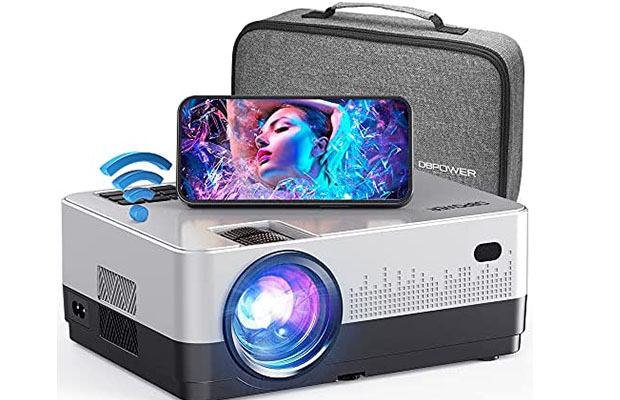
Why We Like It: The DBPOWER Bluetooth Projector, another transportable and useful projector for the classroom, is available if we move up a little in price. Since you can watch native full-high definition content with an 8000-lumen rating, the extra cost is justified.
Pros
- Native 1080p
- 8000 lumens solid brightness
- Hi-Fi stereo sound
- Reduced noise from the cooling fan
- 3-year warranty
- Lifetime support
- A free carrying case included
- Zoom function
- Mirror display function
- Small and compact
- Works with TV stick
Cons
- Mirroring won’t play copyrighted videos
- Short power cord
In addition to Wi-Fi, which is specialized to work well with your phone, there is Bluetooth. By streaming content from a mobile device, you can give your students an HD experience in the classroom.
There are also carrying cases, speakers with SRS built in, a 3-year warranty, and lifetime support as added extras.
6. Topvision T6 Projector
Why We Like It: Over the course of a long lifespan, this projector offers consistent lumens. For a while, you won’t need to be concerned about replacement parts blowing the classroom budget. For a simpler setup, it also has high-quality sound built right in.
Pros
- Extra large screen included
- Uses an HDMI cable
- Connects to entertainment systems
Cons
- Meant for household use
If you frequently play educational TV programs, this projector is the best. It has a built-in screen and connections to several entertainment systems, providing access to a larger library of media. The 15,000-hour lamp has 4,000 lumens inside to produce brilliant projections. You can employ it as a short-throw option when you are as close to the screen as 4.5 feet. It was designed with a home theater in mind initially. Since most educators prefer this quality, it isn’t advised for PowerPoint presentations and other similar types of presentations.
This is a compact choice with a light body. It can be moved between classrooms with ease. Additionally, there is an integrated audio system that enables the entire class to hear whatever you are playing. Better audio quality and less background noise are provided by dual-fan systems. There is also a 3.5mm audio output so you can connect your own speaker if you don’t like the built-in audio. Because it uses more advanced LED technology, it claims to have an average brightness that is 80% higher than other models.
7. PVO Yg300pro Projector
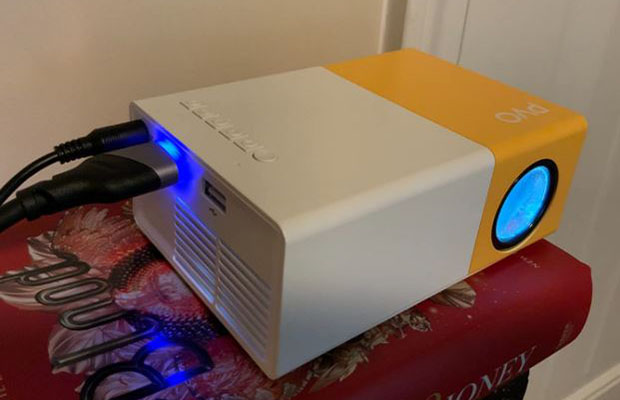
Why We Like It: For teachers and small children, this portable projector is the best. Its appealing exterior appeals to developing minds. There is a lot of technology on the inside that translates into features that teachers want.
Pros
- Can be controlled remotely
- Micro projection option
- Usable in outdoor settings
Cons
- Poor projection ability
A variety of features are available for early childhood educators in this highly mobile option. As long as you try to diffuse it, you can use it in environments with moderate ambient lighting. You have remote control over it, so you can turn it off instantly when you need to. Unfavorable effects of small stature exist. Beyond 150 inches, you can’t project. This shouldn’t be a major problem in small classrooms with young children.
You don’t have to be concerned about wires getting tangled in little hands because the power source is a mini power bank. As long as the micro charger can handle 5V, you can use it to charge most smartphones. A natural resolution of 800 x 480 is supported in 1080P full HD. It can be folded up and thrown into a bag or backpack so you can bring it with you outside, on field trips, and wherever else your class may go. This projector might be among the best outdoor projectors with its features.
8. Hompow 5500L Movie Projector
Why We Like It: The HOMPOW 5500 movie projector is the best option for anyone looking for school projectors that can wire connect to a phone. The best projectors for use in classrooms will have your phone as well as built-in speakers and the ability to connect to external speakers.
Pros
- Supports full HD
- Brighter projector than most
- Hooks up to a phone via cable
- Keystone and focus adjustments
- Portable
- Noise reduction technology for the cooling fan
- Large projection screen
- Comes with a remote control
- Built-in speaker
- Great for classroom presentations as well
Cons
- It May sound better with a separate speaker
- Not the best for very well-lit rooms
The most effective classroom projectors will increase convenience rather than decrease it. The 5500L has noise reduction technology that ensures the fan noise won’t drown out the audio and is more portable than most projectors.
The 5500L supports 1080p, has 80% brighter images, and has a very long lamp life.
9. Azeus Ture 6000
Why We Like It: Because of its size, this particular projector was picked. Because of its 200-inch maximum projected screen size, this portable projector is suitable for use in both small and large classrooms.
Pros
- Large 200-inch screen size
- Supports full HD 1080p
- Education projector with Hi-Fi sound
- Portable design
- Doesn’t require external speakers
- Low noise
- Heat dispersion fan
- Comes with a remote
- Long lamp life
- Keystone correction
- Zoom function
Cons
- The cords will stick out a bit when plugged in
- Remote does not include batteries
The Ture 600 uses LCD display technology and an LED light source, giving you a lamp lifespan of 50,000 hours!
You won’t need to connect an additional speaker to this classroom projector because the Ture 6000 comes with a built-in speaker. The heat dispersion technology will guarantee consistently clear audio from the 5W speaker, which is regarded as Hi-Fi.
10. Epson Epiqvision Ultra LS300

Why We Like It: Despite the fact that a mini projector can be the best option for a school projector and handle the essentials, there is no disputing the fact that spending more will get you more in terms of bells and whistles.
Pros
- Displays up to 4K content
- True 3-chip design
- Chromecast built-in
- Android TV
- Yamaha speakers
- UST projector
- Comes in black and white
- Contrast ratio of 1,500,000:1
- 120-inch projected image
- 3600 lumens image brightness
Cons
- More expensive
- Manual focus and adjustment
You receive built-in Yamaha 2.1 speakers and support for 4K content with the LS300. It is an ultra-short throw projector with 3LCD display technology, a laser array, and a very high contrast ratio. Other features include Android TV and a built-in Chromecast.
What Are Projectors For School?
A classroom projector is a device that connects to a device like a computer, smartphone, tablet, or flash drive to display images or video from that device onto a projection screen, just like any other video projector. A light source is used to make the images larger so they can be viewed clearly from a distance of several feet away.
Reproduced images can be seen even in sizable lecture halls designed like auditoriums, depending on the quality of the projector and the projection screen being used.
When a large group of people must view images on a screen, projectors are useful. Projectors are frequently used in places like conference rooms, board meetings, and classrooms because a computer screen or even a television screen may be too small for a big group to see. Our resource guide on projectors vs. TV has more information.
Is It Worthy To Buy A Projector For Classrooms?
- You are a Visual Educator: A classroom projector is a great option for you if you prefer to instruct using visual materials like videos, images, or diagrams. Numerous studies have demonstrated that using a variety of teaching methods when instructing your students can improve their learning effectiveness. You can implement a visual teaching style with the aid of a projector.
- You want to increase student engagement: Some classroom projectors are interactive as well, allowing your students to stand up from their desks and write, draw, or play games on the screen. For students of any grade level, this can significantly raise engagement and overall learning.
- You Need a Mobile Audio/Visual Solution for Your Classroom: You can profit from a projector’s portability if you’re a substitute teacher or a teacher who frequently moves between classrooms. You won’t have to worry about the classroom having the right technology for you to teach your lessons if you bring your own projector.
Projectors For School Vs. Traditional Projectors
Classroom projectors and conventional projects are nearly identical in almost every way when it comes to core functionality. They both use a variety of connectivity methods to connect to a source, and they both use that source’s video signals to project images onto a projector screen or another flat surface. The majority of projectors also share the same fundamental parts, such as light sources, color wheels, lenses, and mirrors, regardless of their specific type.
When analyzing the particular features and functionalities that make a projector better suited for classroom use, the key distinctions between the two categories come into play. These include:
- Portability: Comparatively to home theater projectors, classroom projectors typically have smaller, more portable designs. As a result, you can easily disconnect the projector and install it in another classroom even in small spaces.
- Brightness: The best projectors for classrooms typically have higher brightness ratings than projectors you’d use in dark spaces because classrooms frequently have bright fluorescent lights or big windows. Your students will all have no trouble seeing the projected images with more lumens of brightness.
- Resolution: You most likely won’t need to think about 4K resolution projectors since you probably won’t be watching the newest superhero movie during class on your projector. Typically, 720p or 1080p resolutions are available on classroom projectors.
- Connectivity: A school projector typically offers a wide variety of versatile connections due to the wide variety of different video source options available in the modern classroom. The best options come with wireless connections, including the ability to connect to mobile devices like an iPad or smartphone, as well as HDMI, USB, VGA, and component ports.
How Durable Is A Classroom Projector?
Projector lamp failure is by far the most frequent issue, despite the fact that the machinery and moving parts in projectors leave room for potential flaws and maintenance requirements. When a projector gets older, a dead bulb usually causes the first issue.
A lamp-based projector typically has a lamp life of around 2,000 hours of operation, but some higher-quality LED and laser projectors have a lifespan of anywhere from 5,000 to 20,000 hours. That means your projector will last anywhere from 6 to 10 years before it needs to be replaced if you use it in your classroom for two hours each day.
If the device is properly maintained and stored, general maintenance on projectors can be kept to a minimum. Make sure your projector is kept as often as possible in a spotless, dust-free environment.
Best Projector For School Buying Guide
A few requirements must be met for a classroom projector to be considered the best. Our media team has put together a quick buyer’s guide that will make sifting through low-quality products much simpler with the aid of our audio team.
Size And Weight
Asking yourself whether you want or need a portable school projector is a good way, according to our audiovisual teams, to summarize this section. Really, only the setup and portability will be impacted by the unit’s size and weight.
Costlier projectors are typically bigger because they contain more and better features, so they are less portable. The best option if you want a home projector that can also be used in a classroom is to choose a small one.
Some of the items we’ve included even have their own carrying cases and weigh less than 7 pounds.
As mentioned, the setup is also impacted by the weight. Large and heavy models will not be easy to mount, but smaller ones may even come with a tripod for better height adjustment and easier setup.
Resolution
The resolution appears next on the list. Finding inexpensive projectors that can provide resolutions higher than full HD can be challenging. Depending on the size of the room or lecture hall, it might be worthwhile to spend more money on a unit that can handle 4K.
The amount of detail you can make out on the screen depends on the resolution of the projector. Nobody enjoys seeing images that are hazy and blurry and where the text is barely legible. No matter where they are seated, everyone in the classroom should be able to clearly see the projected images when you are teaching.
Because of this, our specialists advise a screen size of 100 inches or more and a 1080p resolution. That is the unit to choose if you can find one with a larger and higher-quality resolution.
Brightness
The projected image will be as bright as the projector can make it, regardless of color. A higher number indicates a brighter image according to this criterion, which is expressed in lumens [1]. How bright should the images be, in your opinion? That depends on your surroundings.
The best projectors for use in classrooms may be so bright that they can clearly display images on whiteboards as well! If your environment is very dark, you might not need brightness at that level. Users will typically require a brighter projector if the room has more ambient lighting, according to our media team.
To put it into perspective, the best classroom projector should have at least 2500 lumens, according to our visual specialists.
Display Technology
Display technology should be taken into account next when choosing classroom projectors. The source of light is also mentioned in this section. The three main visual technologies are LCD, LED, and DLP.
As the name implies, LCD projectors use a liquid display technology in which the light generated is reflected from dichroic mirrors onto the LCD panel and then transferred onto the projection screen.
Image creation with LED projectors is much more effective because they use LED light sources. The smallest-footprint projectors have LED technology. A longer-lasting lamp can be achieved by choosing LED units.
Digital light processing, used by DLP projectors, makes use of a rotating color wheel and tiny mirrors. You can probably appreciate the complexity of DLP projectors.
Contrast Ratio
High contrast ratios are unquestionably a feature of the best projectors for use in classrooms. How much contrast is there? It is the difference between an image’s whitest white and its darkest black. The contrast ratio will be indicated as being around 6000:1. The figure before the colon relates to brightness. The brightest portion of an image will be 6000 times brighter than the darkest, according to a contrast ratio of 6000:1.
Ideally, the higher the first number, the better, as a higher contrast ratio will produce clearer and sharper images. A better contrast ratio will obviously cost more, but when you use your unit in a big classroom, it’s worth it.
The LS300, for instance, has a remarkable contrast ratio of 1,500,000:1 so you don’t always have to get the best! A unit with a 6000:1 or higher, according to our experts, will be adequate.
Connectivity Options
The best projector for schools should have a variety of connection options, with a connection to smartphones being the most crucial one depending on the media sources you intend to use.
Our experts advise searching for devices with HDMI, USB, mini USB, and VGA connections. You can stream content to multiple devices, including a laptop, TV box, and more, using the widely used interfaces HDMI, USB, and VGA, which support a wide range of devices.
The ability to connect wirelessly via Bluetooth and Wi-Fi means that interactive projectors can be used without a cable right away. Onboard mobile devices and wireless connections are fantastic. It increases setup options and eliminates the need for tangled cables.
Throw Distance
The throw distance of a projector is crucial when discussing setup options. The throw distance is the distance the projector needs to be from the wall or screen in order to produce a clear image.
Throw distance is divided into four categories: UST (ultra short throw), short throw, standard throw, and long throw.
A few inches may be all that UST projectors require to create a substantial image. These are excellent for keeping out of the way so that there won’t be a steadfast object in the center of your class.
Standard projectors require about 8 feet, while long throw options require more than that. Shorter throw projectors require 5 feet or less. The throw range is entirely dependent on your setup and preferences, according to our media engineers, but bear in mind that shorter throw models are preferred, which also explains why they are frequently more expensive.
Ease Of Use And Setup
It’s crucial to be able to quickly set up a projector in a classroom setting. When you spend a good 30 minutes connecting the projector, kids may start to get restless. According to our team, a device with Wi-Fi or Bluetooth will be much simpler to connect to and won’t restrict your placement options.
Our media team advises choosing plug-and-play cables if you decide to go with a cabled design.
Noise
Similar to a laptop, a projector makes noise because of ineffective cooling, which amplifies the fan noise. If you can find a device with an advanced cooling system, the noise shouldn’t be a problem, according to our qualified media engineers.
Audio
Having built-in speakers is a must for the best projector to use in a classroom. Again, this is a matter of personal preference, but our team felt that testing models with built-in audio systems really eliminated the extra hassle of finding a compatible speaker to connect to.
Since there’s a chance the integrated speakers won’t be loud enough, our team also advises making sure there are outputs that can accommodate speakers.
Our Top Pick
The AZEUS Ture 6000 is the ideal projector for a classroom environment. It is a portable device that does not forgo features because of its portability. It is a fantastic projector with 6000 lumens, a huge screen, and versatile connection options. It functions as a small entertainment system thanks to cutting-edge LCD technology and high-quality speakers.
Conclusion
You should think about the essential features and functionalities you’ll need in a projector before you buy one for your classroom. Take into account how you intend to use your projector while you are teaching as a starting point. You can use this to decide what user-facing controls would work best for your teaching style.
Interactive projectors offer a 3D immersion in the classroom, which is a novel way to reinforce the material covered in school curricula. As the content is clearly visible to the entire class, it offers a fantastic interactive learning experience, easier note-taking opportunities, plenty of teaching flexibility, and reduced eye strain.
Generally speaking, you want a button option with easy-to-press, clearly labeled buttons. You should also take a look at a remote-control option. By purchasing a projector right away, you can improve your students’ classroom experience.


